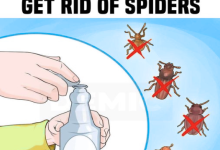It turns out the term “all-purpose” is a bit deceptive.
By Savannah Sher
Names Can Be Deceiving
Despite the name, an all-purpose cleaner isn’t actually ideal for every surface in your home. While these types of cleaning solutions do work well on most household surfaces, in some instances they may not do the best job, or may even cause damage. To prevent staining, discoloration, and other problems, never clean the following surfaces with an all-purpose cleaner.

Glass
While an all-purpose cleaner can be used to clean glass, it won’t perform as well as a dedicated glass cleaner. When it comes to wiping down mirrors, windows, and other glass surfaces, a glass cleaner does a better job of dissolving oil and grease without creating streaks. No matter what type of cleaner you choose, it’s best to clean glass surfaces using a lint-free cloth rather than paper towels to avoid leaving any residue behind.

Carpets and Upholstery
All-purpose cleaners are designed for use on hard surfaces and aren’t formulated for cleaning fabrics like carpets, rugs, curtains, or upholstery. This is one area where purchasing a reliable single-use cleaner is preferable to using a DIY recipe. Because fabrics can stain easily, they should be cleaned only with products that are specified on the care label. It’s important to note that some fabrics require water-based solutions, while others must be treated only with dry-cleaning solvents.

Marble Surfaces
Marble countertops lend an elegant, upscale look to any kitchen or bathroom, but they can be a pain to clean. Because marble is made up largely of calcium carbonate, it doesn’t pair well with acidic substances, which can corrode its surface. Unfortunately, many all-purpose cleaners contain vinegar or lemon juice, acids that can cause lasting damage to marble surfaces. Instead, use a product designed for cleaning stone, or try a DIY solution made up of water and a mild, non-acidic soap.

Wood Furniture
Because wood furniture may be unsealed, it’s best to avoid all-purpose cleaners, which are often filled with relatively harsh cleaning agents. Unless you know what your wood furniture is sealed with, clean it with the gentlest solution possible to avoid staining and other damage. Ideally, just use a little bit of water, or purchase a dedicated wood cleaner to do the job.

Surfaces That Need to Be Disinfected
While all-purpose cleaners do a great job of wiping up spills and getting rid of grime, they typically don’t include disinfecting agents. A proper disinfectant is necessary when you’re trying to rid your home of germs that could potentially make you and your family sick. Use a disinfectant to clean high-touch surfaces like light switches and doorknobs as well as kitchen and bathroom surfaces that may be harboring bacteria.

Shower and Tub
Because of the limescale and mildew that can build up in the bathtub and shower, these surfaces require stronger, more abrasive cleaners. Bathroom cleansers are generally made to be compatible with tile, stone, porcelain, and ceramic, and contain active ingredients that work to eliminate soap scum and mold.

Stains
All-purpose cleaners are designed for maintenance cleaning, not stain removal. Whether you’re dealing with a hard or soft surface, a specially formulated stain remover is the best tool to get the job done. The process for removing stains varies depending on the surface in question and the product you choose, with unique solutions available for concrete, wood, laundry, and mattresses.

Toys
Anyone who has kids knows that pretty much anything they come into contact with requires frequent cleaning—including their toys. Because children have a tendency to put things in their mouths, however, it’s not prudent to use an all-purpose cleaner on their toys, especially small toys that are tempting to chew on. The chemicals in cleaning agents can be dangerous if ingested and may have adverse effects even in small quantities. Instead, wipe down toys with warm water, or clean non-electronic plastic toys in the top rack of the dishwasher.







